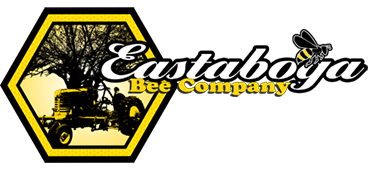
With his dog, Jake, by his side and a smoker in his hands, Justin Hill is only slightly joking when he says his coworkers are honeybees. He doesn’t need to wear gloves anymore, but pulls on his veiled hat as he laughs and says, “Let’s go charm a bee.”
The owner of Eastaboga Bee Company began keeping bees on his 300-acre farm six years ago. A fourth-generation farmer, Hill was already growing fruits and vegetables and raising horses and cattle, but he was eager to try something new.
“I think there are a lot of people that do this as a hobby, but I don’t know that a lot of people do it to make money,” he said. “I was looking for another way to diversify. It’s just like any other small business venture except I’m a farmer, too.”
Hill had the time and the space, but knew nothing about honeybees. He started reading books about beekeeping, and met with beekeepers from across the state to learn from their experience. He has learned a lot along the way, but says he’s still learning.
“Everything changes daily, weekly,” Hill said. “The challenge that you had last week is not the challenge you’re going to have this week.”
In the beginning, the greatest challenge to the self-taught beekeeper was simply getting over the fear of handling the bees to harvest the honey, Hill said. He tried to concentrate on everything he learned and to remember everything he read, but when he heard the buzz of thousands of angry honeybees, his natural instinct told him to run. He didn’t though, and now, after years of harvesting honey, Hill has 80 beehives on his farm.
“I just try to give them a great environment to flourish,” Hill said. “You can’t make them grow, but if you set them up with everything they need, they will grow.”
Hill’s honeybees make their home in white painted boxes built from trees that fell during the April 2011 storms. Most of the boxes are grouped together, while a few sit alone in the distance under the trees where Hill captured their swarms.
With all his hives, Hill quickly realized he could sell more than just jars of raw honey. As he had done before, Hill taught himself to make new products through trial and error, and a lot of reading. He said he threw away trash cans full of trials gone badly until he eventually got it right.
“I was just so proud to have made something,” he said.
In addition to honey, Eastaboga Bee Company now sells multiple products, including soaps, lotions and lip balms. One of the most popular products is the vanilla-scented body butter made with cocoa butter and beeswax. All of Hill’s honey creations can be found in co-ops and at festivals throughout the state, and can be purchased on the company’s website, eastabogabeecompany.com, as well. Hill’s honey is also used in other locally produced products like Richard Sherrod’s Angry Apricot Mustard sauce, and in Cheaha Brewing Company’s Heather Ale. Since branching out, Hill has seen an increase in sales both online and in specialty stores that carry his products.
One such store belongs to Susan Smith, owner of Girlfriends in Oxford, who says the honey is the most popular Eastaboga Bee Company product they sell.
“People buy it because it’s made locally,” she said. “Those that have bought it have come back for more. Several of us in the shop buy it and use it ourselves.”
Hill hopes to one day open a store of his own where people can learn about honeybees while trying his products. He has some new products in the works, including a hair balm that will be available this summer.
Hill plans to stop at 300 hives because “that’s all one or two people can do,” he said. In the meantime, he will continue adding hives and searching for ways to protect his honeybees from the same threats facing every beekeeper — mites and disease, for instance, can destroy an entire colony.
In the last few years, studies conducted by the U.S. Department of Agriculture have found the honeybee population is decreasing, which the department says threatens crop yields because “bee pollination is responsible for more than $15 billion in increased crop value each year.” No single cause has been determined, but according to the USDA website, scientists believe it could be a combination of pathogens, parasites, stress and pollen scarcity.
Hill said he likes to think he is helping the bees, even if he is only playing a small part.
“It’s not why I started doing this, but it’s nice to think I might be making a difference,” he said.
He offers everyone the same advice — advice that might just help them and the honeybees at the same time: “Plant a flower and call your mother.”
By: Laura Monroe
http://www.annistonstar.com/life/busy-as-a-bee-eastaboga-bee-company-tackles-more-than/article_ac5a8604-e8a5-11e3-8bc1-0019bb2963f4.html







